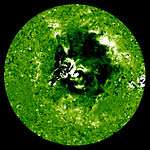Moreton wave

A Moreton-Ramsey wave is the chromospheric signature of a large-scale solar coronal shock wave. Described as a kind of solar "tsunami",[1] they are generated by solar flares. They are named for American astronomer Gail Moreton and Harry E Ramsey, Moreton an observer at the Lockheed Solar Observatory in Burbank Harry E Ramsey The Observer who spotted them in 1959 at The Sacremento Peak Observatory.[2][3][4] He discovered them in time-lapse photography of the chromosphere in the light of the Balmer alpha transition.
There were few follow-up studies for decades. Then the 1995 launch of the Solar and Heliospheric Observatory led to observation of coronal waves, which cause Moreton waves. Moreton waves were a research topic again. (SOHO's EIT instrument discovered another, different wave type called "EIT waves".) [5] The reality of Moreton waves (a.k.a. fast-mode MHD waves) has also been confirmed by the two STEREO spacecraft. They observed a 100,000-km-high wave of hot plasma and magnetism, moving at 250 km/s, in conjunction with a big coronal mass ejection in February 2009.[6][7]

Moreton measured the waves propagating at a speed of 500–1500 km/s.[6] Yutaka Uchida interpreted Moreton waves as MHD fast mode shock waves propagating in the corona.[8] He links them to type II radio bursts, which are radio-wave discharges created when coronal mass ejections accelerate shocks.[9]
Moreton waves can be observed primarily in the Hα band.[10]
See also
- Solar transition region
- Spicule (solar physics)
- Solar prominence
- Gravity wave
- Helioseismology
- Asteroseismology
- OSO 8
References
- ↑ Phillips, Tony (November 24, 2009). "Monster Waves on the Sun are Real". NASA. Retrieved 16 July 2010.
- ↑ Moreton, G. E. (1960). "Hα Observations of Flare-Initiated Disturbances with Velocities ~1000 km/sec". Astronomical Journal. 65: 494. Bibcode:1960AJ.....65U.494M. doi:10.1086/108346.
- ↑ Moreton, G. E. & Ramsey, H. E. (1960). "Recent Observations of Dynamical Phenomena Associated with Solar Flares". Publications of the Astronomical Society of the Pacific. 72 (428): 357. Bibcode:1960PASP...72..357M. doi:10.1086/127549.
- ↑ Athay, R. Grant; Moreton, Gail E. (1961). "Impulsive Phenomena of the Solar Atmosphere. I. Some Optical Events Associated with Flares Showing Explosive Phase". Astrophysical Journal. 133: 935. Bibcode:1961ApJ...133..935A. doi:10.1086/147098.
- ↑ Thompson, B.; Plunkett, S. P.; Gurman, J. B.; Newmark, J.S.; St. Cyr, O.C.; Michels, D.J. (1998). "SOHO/EIT observations of an Earth-directed coronal mass ejection on May 12, 1997". Geophysical Research Letters. 25: 2465–2468. Bibcode:1998GeoRL..25.2465T. doi:10.1029/98GL50429.
- 1 2 Atkins, William (26 November 2009). "STEREO spacecraft finds gigantic tsunami on Sun". iTWire. Retrieved 16 July 2010.
- ↑ JPL/NASA (November 19, 2009). "Mystery of the Solar Tsunami -- Solved". PhysOrg.com. Retrieved 16 July 2010.
- ↑ Sakurai, Takashi (3 September 2002). "SolarNews Newsletter". Solar Physics Division, American Astronomical Society. Retrieved 15 June 2011.
- ↑ Layton, Laura (May 15, 2009). "STEREO Spies First Major Activity of Solar Cycle 24". NASA. Retrieved 15 June 2011.
- ↑ Narukage, N.; Eto, Shigeru; Kadota, Miwako; Kitai, Reizaburo; Kurokawa, Hiroki; Shibata, Kazunari (2004). "Moreton waves observed at Hida Observatory" (PDF). Proceedings IAU Symposium. 2004 (223): 367–370. doi:10.1017/S1743921304006143. Retrieved 2006-12-11.
- More of Moreton's papers can be found here (SAO/NASA System).
External links
- "Have you ever heard the Sun?" - many recordings (MP3 format) of solar radio emissions including a solar flare shockfront.
